LL5301 Land Law - Concept 2019: Fixtures, Chattels, and Legal Rights
VerifiedAdded on 2022/08/13
|42
|11535
|97
Case Study
AI Summary
This Land Law assignment examines the rights of a property owner, Raheem, concerning fixtures and chattels within a purchased property named 'Concept 2019'. The case analyzes the legal status of a titanium fence, an LCD screen, and a nameplate, determining whether they constitute fixtures or chattels under the Law of Property Act 1925. The analysis considers the degree and purpose of annexation, the intention of the parties, and relevant case law, including Hellawell v Eastwood and Elitestone Ltd v Morris. The assignment also addresses potential remedies for the wrongful removal of items and the application of the gravity test. The conclusion determines Raheem's rights over the fixtures and his ability to claim damages from the previous owner.
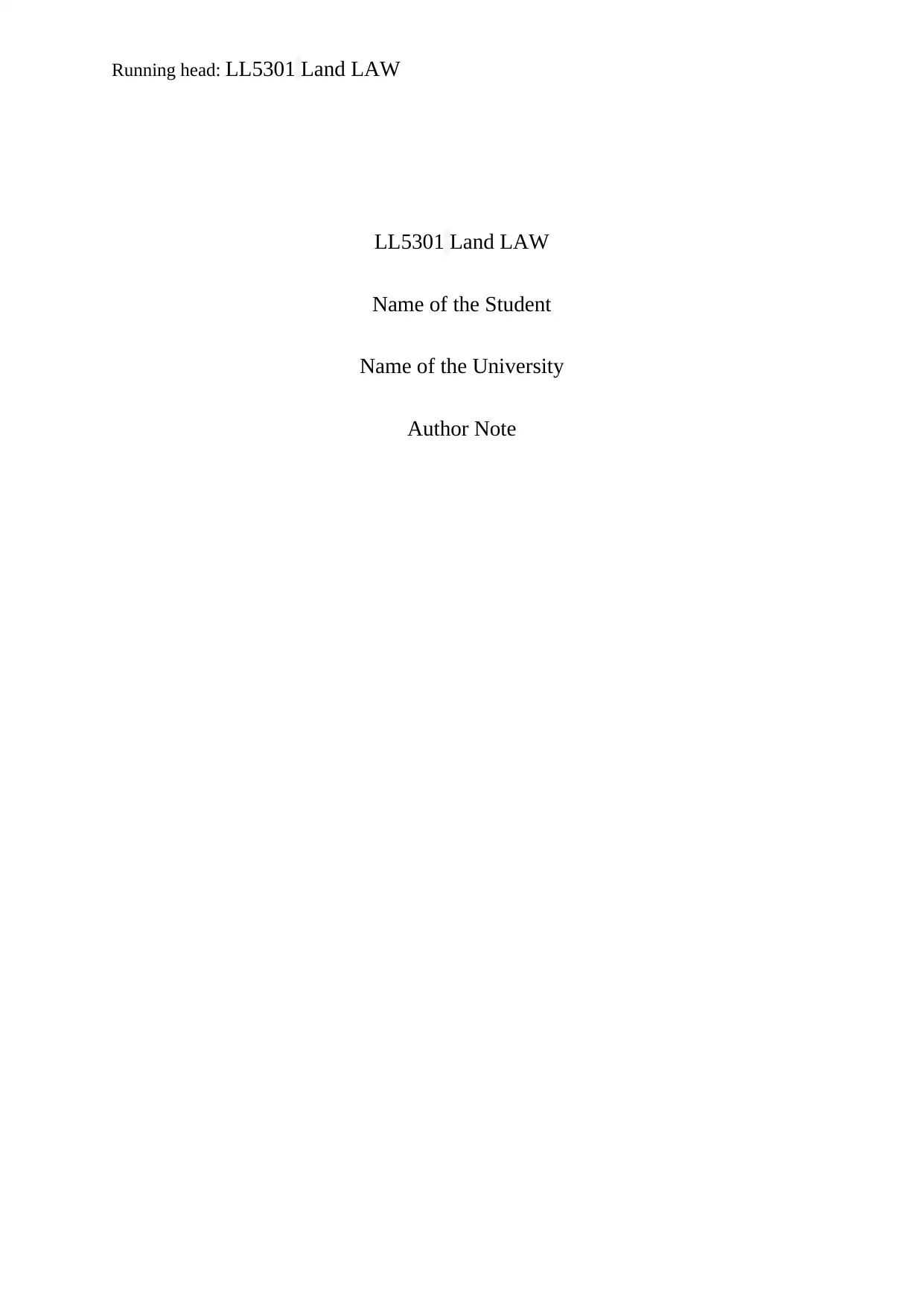
Running head: LL5301 Land LAW
LL5301 Land LAW
Name of the Student
Name of the University
Author Note
LL5301 Land LAW
Name of the Student
Name of the University
Author Note
Paraphrase This Document
Need a fresh take? Get an instant paraphrase of this document with our AI Paraphraser
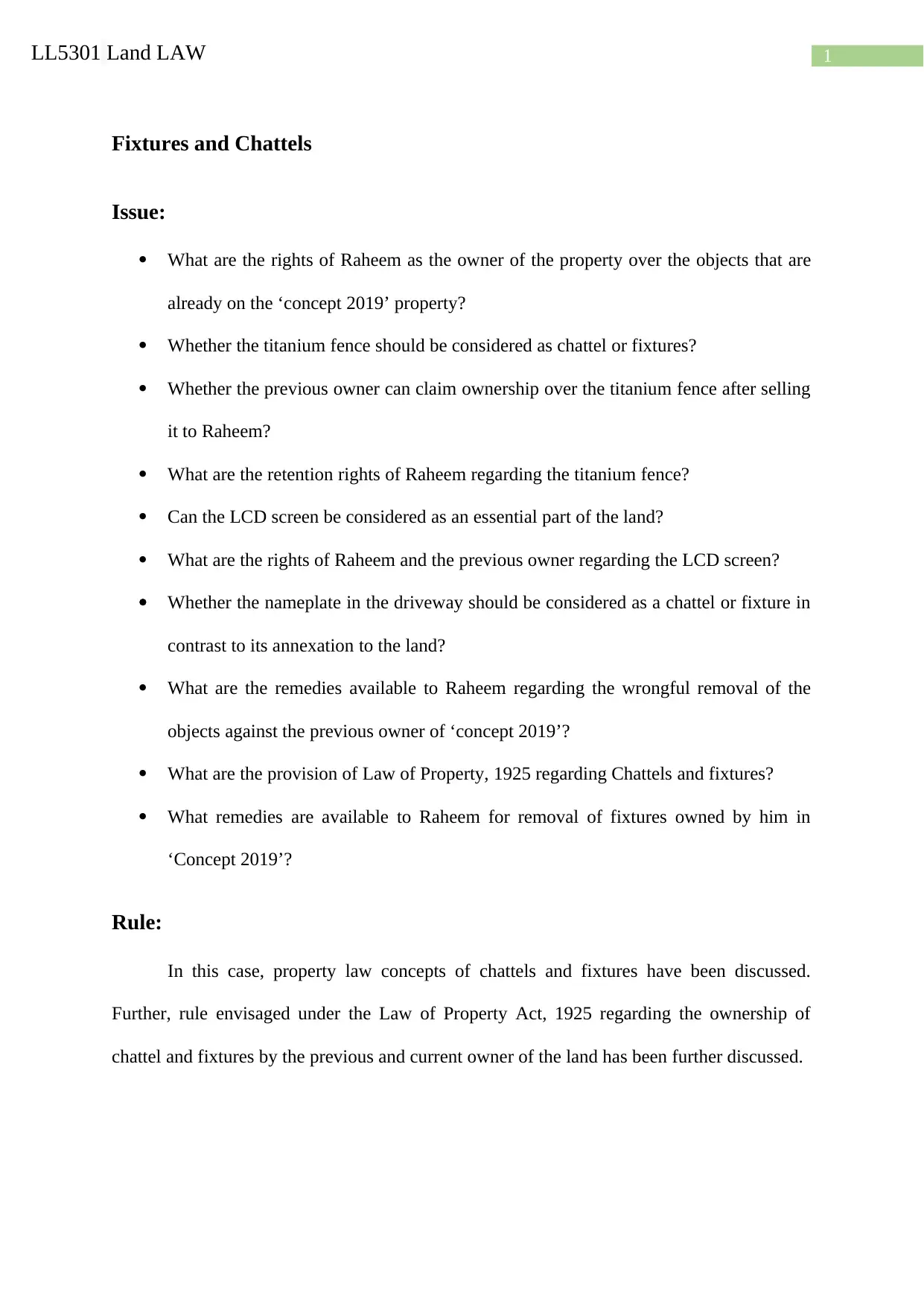
1LL5301 Land LAW
Fixtures and Chattels
Issue:
What are the rights of Raheem as the owner of the property over the objects that are
already on the ‘concept 2019’ property?
Whether the titanium fence should be considered as chattel or fixtures?
Whether the previous owner can claim ownership over the titanium fence after selling
it to Raheem?
What are the retention rights of Raheem regarding the titanium fence?
Can the LCD screen be considered as an essential part of the land?
What are the rights of Raheem and the previous owner regarding the LCD screen?
Whether the nameplate in the driveway should be considered as a chattel or fixture in
contrast to its annexation to the land?
What are the remedies available to Raheem regarding the wrongful removal of the
objects against the previous owner of ‘concept 2019’?
What are the provision of Law of Property, 1925 regarding Chattels and fixtures?
What remedies are available to Raheem for removal of fixtures owned by him in
‘Concept 2019’?
Rule:
In this case, property law concepts of chattels and fixtures have been discussed.
Further, rule envisaged under the Law of Property Act, 1925 regarding the ownership of
chattel and fixtures by the previous and current owner of the land has been further discussed.
Fixtures and Chattels
Issue:
What are the rights of Raheem as the owner of the property over the objects that are
already on the ‘concept 2019’ property?
Whether the titanium fence should be considered as chattel or fixtures?
Whether the previous owner can claim ownership over the titanium fence after selling
it to Raheem?
What are the retention rights of Raheem regarding the titanium fence?
Can the LCD screen be considered as an essential part of the land?
What are the rights of Raheem and the previous owner regarding the LCD screen?
Whether the nameplate in the driveway should be considered as a chattel or fixture in
contrast to its annexation to the land?
What are the remedies available to Raheem regarding the wrongful removal of the
objects against the previous owner of ‘concept 2019’?
What are the provision of Law of Property, 1925 regarding Chattels and fixtures?
What remedies are available to Raheem for removal of fixtures owned by him in
‘Concept 2019’?
Rule:
In this case, property law concepts of chattels and fixtures have been discussed.
Further, rule envisaged under the Law of Property Act, 1925 regarding the ownership of
chattel and fixtures by the previous and current owner of the land has been further discussed.
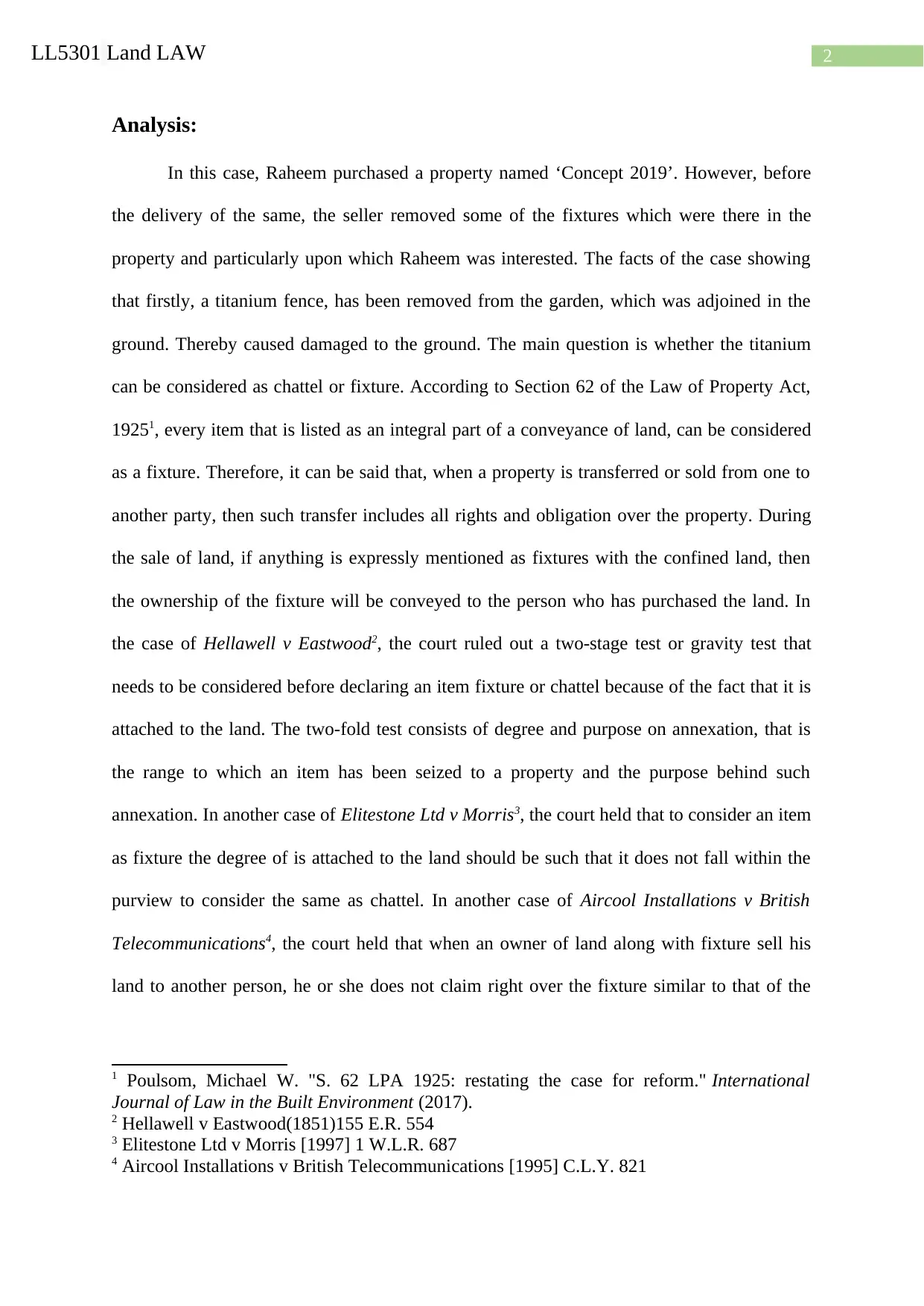
2LL5301 Land LAW
Analysis:
In this case, Raheem purchased a property named ‘Concept 2019’. However, before
the delivery of the same, the seller removed some of the fixtures which were there in the
property and particularly upon which Raheem was interested. The facts of the case showing
that firstly, a titanium fence, has been removed from the garden, which was adjoined in the
ground. Thereby caused damaged to the ground. The main question is whether the titanium
can be considered as chattel or fixture. According to Section 62 of the Law of Property Act,
19251, every item that is listed as an integral part of a conveyance of land, can be considered
as a fixture. Therefore, it can be said that, when a property is transferred or sold from one to
another party, then such transfer includes all rights and obligation over the property. During
the sale of land, if anything is expressly mentioned as fixtures with the confined land, then
the ownership of the fixture will be conveyed to the person who has purchased the land. In
the case of Hellawell v Eastwood2, the court ruled out a two-stage test or gravity test that
needs to be considered before declaring an item fixture or chattel because of the fact that it is
attached to the land. The two-fold test consists of degree and purpose on annexation, that is
the range to which an item has been seized to a property and the purpose behind such
annexation. In another case of Elitestone Ltd v Morris3, the court held that to consider an item
as fixture the degree of is attached to the land should be such that it does not fall within the
purview to consider the same as chattel. In another case of Aircool Installations v British
Telecommunications4, the court held that when an owner of land along with fixture sell his
land to another person, he or she does not claim right over the fixture similar to that of the
1 Poulsom, Michael W. "S. 62 LPA 1925: restating the case for reform." International
Journal of Law in the Built Environment (2017).
2 Hellawell v Eastwood(1851)155 E.R. 554
3 Elitestone Ltd v Morris [1997] 1 W.L.R. 687
4 Aircool Installations v British Telecommunications [1995] C.L.Y. 821
Analysis:
In this case, Raheem purchased a property named ‘Concept 2019’. However, before
the delivery of the same, the seller removed some of the fixtures which were there in the
property and particularly upon which Raheem was interested. The facts of the case showing
that firstly, a titanium fence, has been removed from the garden, which was adjoined in the
ground. Thereby caused damaged to the ground. The main question is whether the titanium
can be considered as chattel or fixture. According to Section 62 of the Law of Property Act,
19251, every item that is listed as an integral part of a conveyance of land, can be considered
as a fixture. Therefore, it can be said that, when a property is transferred or sold from one to
another party, then such transfer includes all rights and obligation over the property. During
the sale of land, if anything is expressly mentioned as fixtures with the confined land, then
the ownership of the fixture will be conveyed to the person who has purchased the land. In
the case of Hellawell v Eastwood2, the court ruled out a two-stage test or gravity test that
needs to be considered before declaring an item fixture or chattel because of the fact that it is
attached to the land. The two-fold test consists of degree and purpose on annexation, that is
the range to which an item has been seized to a property and the purpose behind such
annexation. In another case of Elitestone Ltd v Morris3, the court held that to consider an item
as fixture the degree of is attached to the land should be such that it does not fall within the
purview to consider the same as chattel. In another case of Aircool Installations v British
Telecommunications4, the court held that when an owner of land along with fixture sell his
land to another person, he or she does not claim right over the fixture similar to that of the
1 Poulsom, Michael W. "S. 62 LPA 1925: restating the case for reform." International
Journal of Law in the Built Environment (2017).
2 Hellawell v Eastwood(1851)155 E.R. 554
3 Elitestone Ltd v Morris [1997] 1 W.L.R. 687
4 Aircool Installations v British Telecommunications [1995] C.L.Y. 821
⊘ This is a preview!⊘
Do you want full access?
Subscribe today to unlock all pages.

Trusted by 1+ million students worldwide
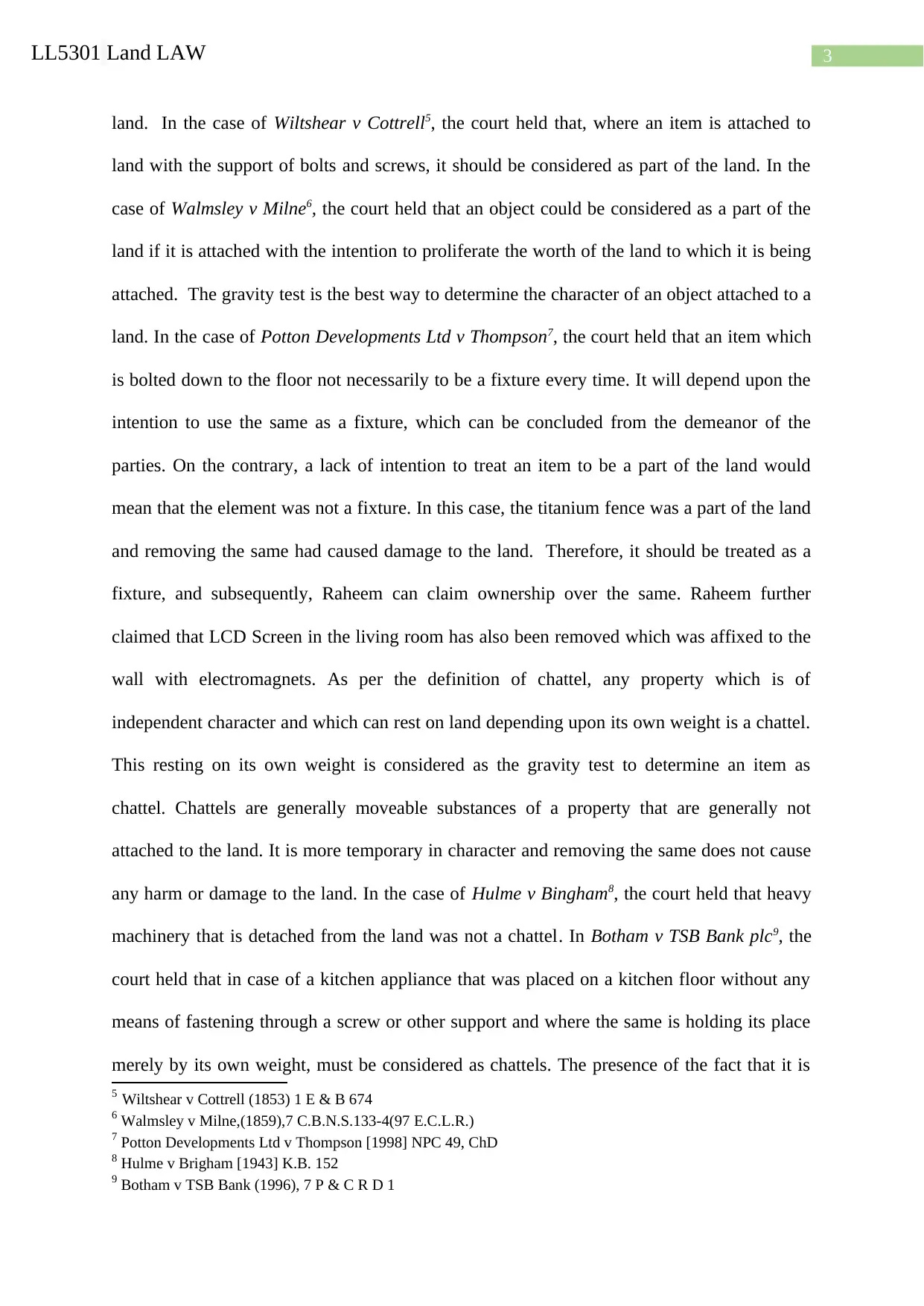
3LL5301 Land LAW
land. In the case of Wiltshear v Cottrell5, the court held that, where an item is attached to
land with the support of bolts and screws, it should be considered as part of the land. In the
case of Walmsley v Milne6, the court held that an object could be considered as a part of the
land if it is attached with the intention to proliferate the worth of the land to which it is being
attached. The gravity test is the best way to determine the character of an object attached to a
land. In the case of Potton Developments Ltd v Thompson7, the court held that an item which
is bolted down to the floor not necessarily to be a fixture every time. It will depend upon the
intention to use the same as a fixture, which can be concluded from the demeanor of the
parties. On the contrary, a lack of intention to treat an item to be a part of the land would
mean that the element was not a fixture. In this case, the titanium fence was a part of the land
and removing the same had caused damage to the land. Therefore, it should be treated as a
fixture, and subsequently, Raheem can claim ownership over the same. Raheem further
claimed that LCD Screen in the living room has also been removed which was affixed to the
wall with electromagnets. As per the definition of chattel, any property which is of
independent character and which can rest on land depending upon its own weight is a chattel.
This resting on its own weight is considered as the gravity test to determine an item as
chattel. Chattels are generally moveable substances of a property that are generally not
attached to the land. It is more temporary in character and removing the same does not cause
any harm or damage to the land. In the case of Hulme v Bingham8, the court held that heavy
machinery that is detached from the land was not a chattel. In Botham v TSB Bank plc9, the
court held that in case of a kitchen appliance that was placed on a kitchen floor without any
means of fastening through a screw or other support and where the same is holding its place
merely by its own weight, must be considered as chattels. The presence of the fact that it is
5 Wiltshear v Cottrell (1853) 1 E & B 674
6 Walmsley v Milne,(1859),7 C.B.N.S.133-4(97 E.C.L.R.)
7 Potton Developments Ltd v Thompson [1998] NPC 49, ChD
8 Hulme v Brigham [1943] K.B. 152
9 Botham v TSB Bank (1996), 7 P & C R D 1
land. In the case of Wiltshear v Cottrell5, the court held that, where an item is attached to
land with the support of bolts and screws, it should be considered as part of the land. In the
case of Walmsley v Milne6, the court held that an object could be considered as a part of the
land if it is attached with the intention to proliferate the worth of the land to which it is being
attached. The gravity test is the best way to determine the character of an object attached to a
land. In the case of Potton Developments Ltd v Thompson7, the court held that an item which
is bolted down to the floor not necessarily to be a fixture every time. It will depend upon the
intention to use the same as a fixture, which can be concluded from the demeanor of the
parties. On the contrary, a lack of intention to treat an item to be a part of the land would
mean that the element was not a fixture. In this case, the titanium fence was a part of the land
and removing the same had caused damage to the land. Therefore, it should be treated as a
fixture, and subsequently, Raheem can claim ownership over the same. Raheem further
claimed that LCD Screen in the living room has also been removed which was affixed to the
wall with electromagnets. As per the definition of chattel, any property which is of
independent character and which can rest on land depending upon its own weight is a chattel.
This resting on its own weight is considered as the gravity test to determine an item as
chattel. Chattels are generally moveable substances of a property that are generally not
attached to the land. It is more temporary in character and removing the same does not cause
any harm or damage to the land. In the case of Hulme v Bingham8, the court held that heavy
machinery that is detached from the land was not a chattel. In Botham v TSB Bank plc9, the
court held that in case of a kitchen appliance that was placed on a kitchen floor without any
means of fastening through a screw or other support and where the same is holding its place
merely by its own weight, must be considered as chattels. The presence of the fact that it is
5 Wiltshear v Cottrell (1853) 1 E & B 674
6 Walmsley v Milne,(1859),7 C.B.N.S.133-4(97 E.C.L.R.)
7 Potton Developments Ltd v Thompson [1998] NPC 49, ChD
8 Hulme v Brigham [1943] K.B. 152
9 Botham v TSB Bank (1996), 7 P & C R D 1
Paraphrase This Document
Need a fresh take? Get an instant paraphrase of this document with our AI Paraphraser
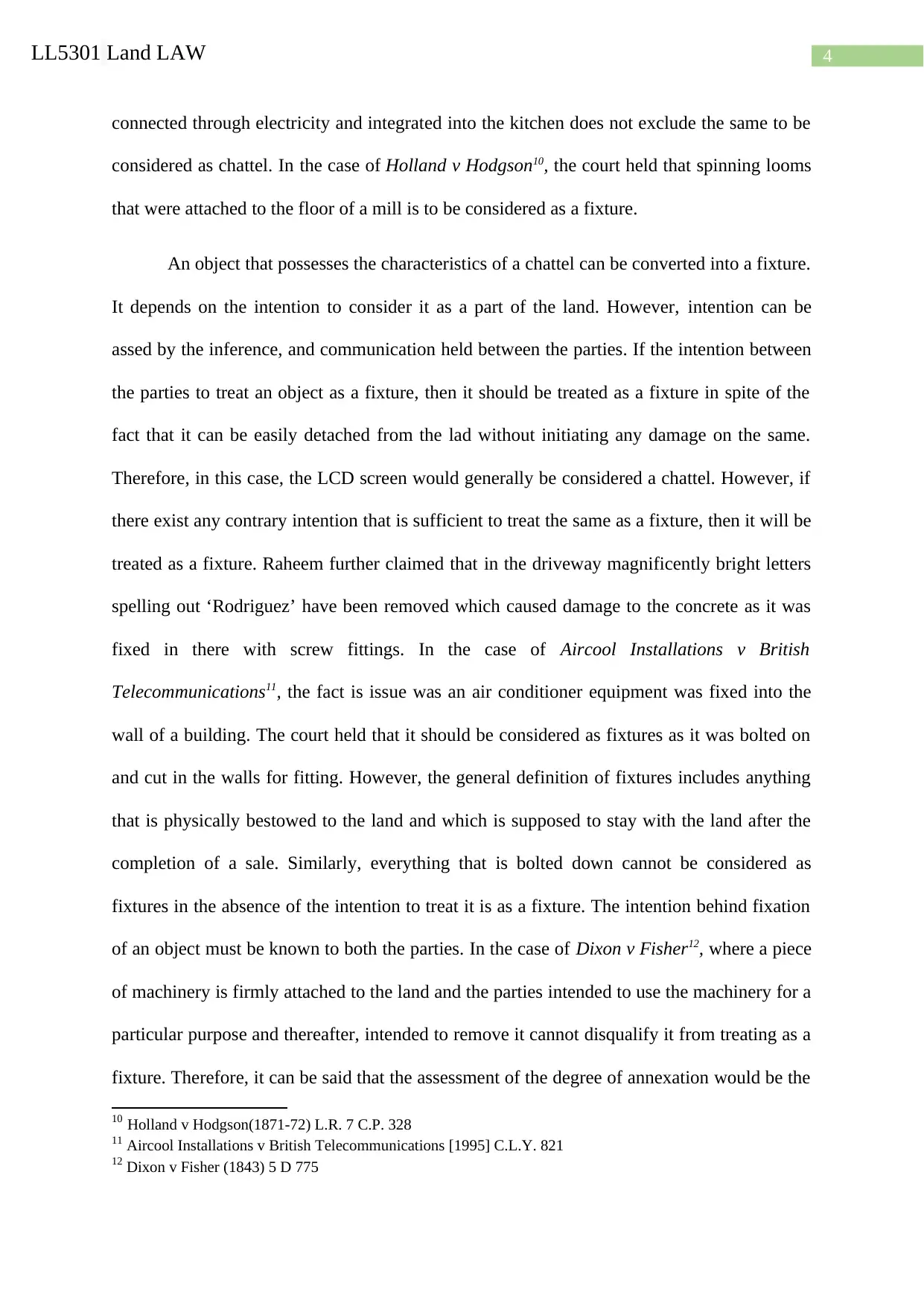
4LL5301 Land LAW
connected through electricity and integrated into the kitchen does not exclude the same to be
considered as chattel. In the case of Holland v Hodgson10, the court held that spinning looms
that were attached to the floor of a mill is to be considered as a fixture.
An object that possesses the characteristics of a chattel can be converted into a fixture.
It depends on the intention to consider it as a part of the land. However, intention can be
assed by the inference, and communication held between the parties. If the intention between
the parties to treat an object as a fixture, then it should be treated as a fixture in spite of the
fact that it can be easily detached from the lad without initiating any damage on the same.
Therefore, in this case, the LCD screen would generally be considered a chattel. However, if
there exist any contrary intention that is sufficient to treat the same as a fixture, then it will be
treated as a fixture. Raheem further claimed that in the driveway magnificently bright letters
spelling out ‘Rodriguez’ have been removed which caused damage to the concrete as it was
fixed in there with screw fittings. In the case of Aircool Installations v British
Telecommunications11, the fact is issue was an air conditioner equipment was fixed into the
wall of a building. The court held that it should be considered as fixtures as it was bolted on
and cut in the walls for fitting. However, the general definition of fixtures includes anything
that is physically bestowed to the land and which is supposed to stay with the land after the
completion of a sale. Similarly, everything that is bolted down cannot be considered as
fixtures in the absence of the intention to treat it is as a fixture. The intention behind fixation
of an object must be known to both the parties. In the case of Dixon v Fisher12, where a piece
of machinery is firmly attached to the land and the parties intended to use the machinery for a
particular purpose and thereafter, intended to remove it cannot disqualify it from treating as a
fixture. Therefore, it can be said that the assessment of the degree of annexation would be the
10 Holland v Hodgson(1871-72) L.R. 7 C.P. 328
11 Aircool Installations v British Telecommunications [1995] C.L.Y. 821
12 Dixon v Fisher (1843) 5 D 775
connected through electricity and integrated into the kitchen does not exclude the same to be
considered as chattel. In the case of Holland v Hodgson10, the court held that spinning looms
that were attached to the floor of a mill is to be considered as a fixture.
An object that possesses the characteristics of a chattel can be converted into a fixture.
It depends on the intention to consider it as a part of the land. However, intention can be
assed by the inference, and communication held between the parties. If the intention between
the parties to treat an object as a fixture, then it should be treated as a fixture in spite of the
fact that it can be easily detached from the lad without initiating any damage on the same.
Therefore, in this case, the LCD screen would generally be considered a chattel. However, if
there exist any contrary intention that is sufficient to treat the same as a fixture, then it will be
treated as a fixture. Raheem further claimed that in the driveway magnificently bright letters
spelling out ‘Rodriguez’ have been removed which caused damage to the concrete as it was
fixed in there with screw fittings. In the case of Aircool Installations v British
Telecommunications11, the fact is issue was an air conditioner equipment was fixed into the
wall of a building. The court held that it should be considered as fixtures as it was bolted on
and cut in the walls for fitting. However, the general definition of fixtures includes anything
that is physically bestowed to the land and which is supposed to stay with the land after the
completion of a sale. Similarly, everything that is bolted down cannot be considered as
fixtures in the absence of the intention to treat it is as a fixture. The intention behind fixation
of an object must be known to both the parties. In the case of Dixon v Fisher12, where a piece
of machinery is firmly attached to the land and the parties intended to use the machinery for a
particular purpose and thereafter, intended to remove it cannot disqualify it from treating as a
fixture. Therefore, it can be said that the assessment of the degree of annexation would be the
10 Holland v Hodgson(1871-72) L.R. 7 C.P. 328
11 Aircool Installations v British Telecommunications [1995] C.L.Y. 821
12 Dixon v Fisher (1843) 5 D 775
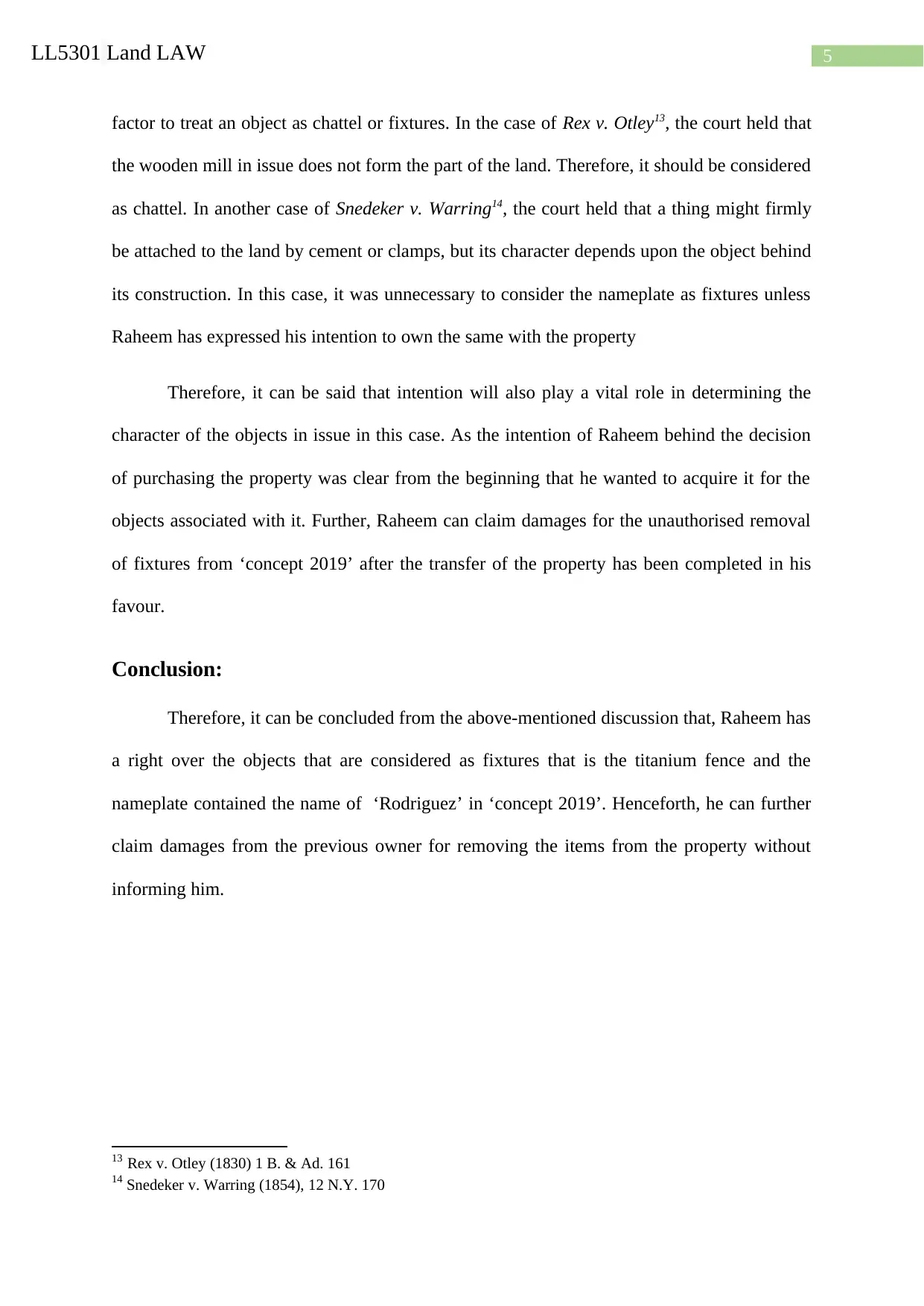
5LL5301 Land LAW
factor to treat an object as chattel or fixtures. In the case of Rex v. Otley13, the court held that
the wooden mill in issue does not form the part of the land. Therefore, it should be considered
as chattel. In another case of Snedeker v. Warring14, the court held that a thing might firmly
be attached to the land by cement or clamps, but its character depends upon the object behind
its construction. In this case, it was unnecessary to consider the nameplate as fixtures unless
Raheem has expressed his intention to own the same with the property
Therefore, it can be said that intention will also play a vital role in determining the
character of the objects in issue in this case. As the intention of Raheem behind the decision
of purchasing the property was clear from the beginning that he wanted to acquire it for the
objects associated with it. Further, Raheem can claim damages for the unauthorised removal
of fixtures from ‘concept 2019’ after the transfer of the property has been completed in his
favour.
Conclusion:
Therefore, it can be concluded from the above-mentioned discussion that, Raheem has
a right over the objects that are considered as fixtures that is the titanium fence and the
nameplate contained the name of ‘Rodriguez’ in ‘concept 2019’. Henceforth, he can further
claim damages from the previous owner for removing the items from the property without
informing him.
13 Rex v. Otley (1830) 1 B. & Ad. 161
14 Snedeker v. Warring (1854), 12 N.Y. 170
factor to treat an object as chattel or fixtures. In the case of Rex v. Otley13, the court held that
the wooden mill in issue does not form the part of the land. Therefore, it should be considered
as chattel. In another case of Snedeker v. Warring14, the court held that a thing might firmly
be attached to the land by cement or clamps, but its character depends upon the object behind
its construction. In this case, it was unnecessary to consider the nameplate as fixtures unless
Raheem has expressed his intention to own the same with the property
Therefore, it can be said that intention will also play a vital role in determining the
character of the objects in issue in this case. As the intention of Raheem behind the decision
of purchasing the property was clear from the beginning that he wanted to acquire it for the
objects associated with it. Further, Raheem can claim damages for the unauthorised removal
of fixtures from ‘concept 2019’ after the transfer of the property has been completed in his
favour.
Conclusion:
Therefore, it can be concluded from the above-mentioned discussion that, Raheem has
a right over the objects that are considered as fixtures that is the titanium fence and the
nameplate contained the name of ‘Rodriguez’ in ‘concept 2019’. Henceforth, he can further
claim damages from the previous owner for removing the items from the property without
informing him.
13 Rex v. Otley (1830) 1 B. & Ad. 161
14 Snedeker v. Warring (1854), 12 N.Y. 170
⊘ This is a preview!⊘
Do you want full access?
Subscribe today to unlock all pages.

Trusted by 1+ million students worldwide
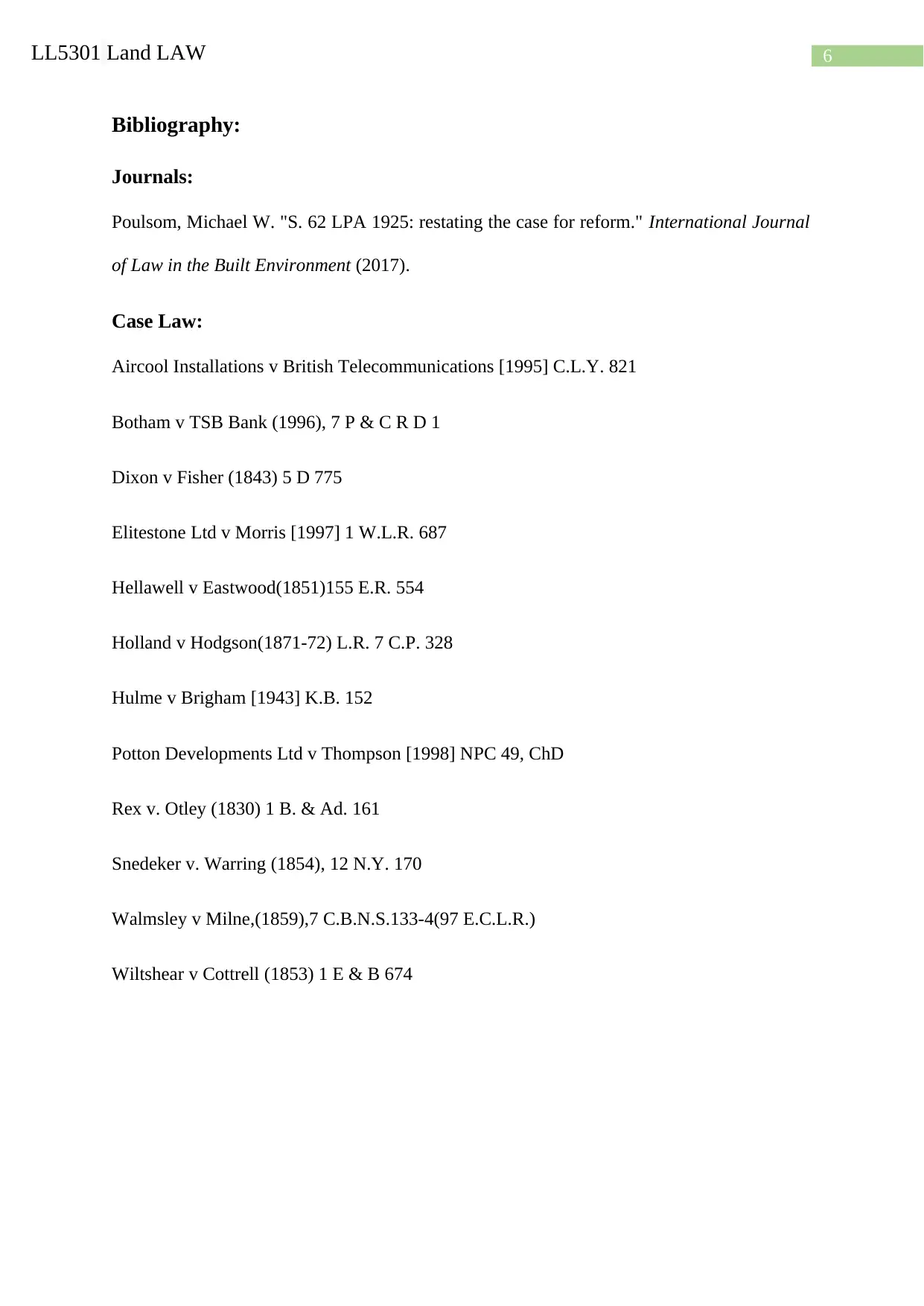
6LL5301 Land LAW
Bibliography:
Journals:
Poulsom, Michael W. "S. 62 LPA 1925: restating the case for reform." International Journal
of Law in the Built Environment (2017).
Case Law:
Aircool Installations v British Telecommunications [1995] C.L.Y. 821
Botham v TSB Bank (1996), 7 P & C R D 1
Dixon v Fisher (1843) 5 D 775
Elitestone Ltd v Morris [1997] 1 W.L.R. 687
Hellawell v Eastwood(1851)155 E.R. 554
Holland v Hodgson(1871-72) L.R. 7 C.P. 328
Hulme v Brigham [1943] K.B. 152
Potton Developments Ltd v Thompson [1998] NPC 49, ChD
Rex v. Otley (1830) 1 B. & Ad. 161
Snedeker v. Warring (1854), 12 N.Y. 170
Walmsley v Milne,(1859),7 C.B.N.S.133-4(97 E.C.L.R.)
Wiltshear v Cottrell (1853) 1 E & B 674
Bibliography:
Journals:
Poulsom, Michael W. "S. 62 LPA 1925: restating the case for reform." International Journal
of Law in the Built Environment (2017).
Case Law:
Aircool Installations v British Telecommunications [1995] C.L.Y. 821
Botham v TSB Bank (1996), 7 P & C R D 1
Dixon v Fisher (1843) 5 D 775
Elitestone Ltd v Morris [1997] 1 W.L.R. 687
Hellawell v Eastwood(1851)155 E.R. 554
Holland v Hodgson(1871-72) L.R. 7 C.P. 328
Hulme v Brigham [1943] K.B. 152
Potton Developments Ltd v Thompson [1998] NPC 49, ChD
Rex v. Otley (1830) 1 B. & Ad. 161
Snedeker v. Warring (1854), 12 N.Y. 170
Walmsley v Milne,(1859),7 C.B.N.S.133-4(97 E.C.L.R.)
Wiltshear v Cottrell (1853) 1 E & B 674
Paraphrase This Document
Need a fresh take? Get an instant paraphrase of this document with our AI Paraphraser
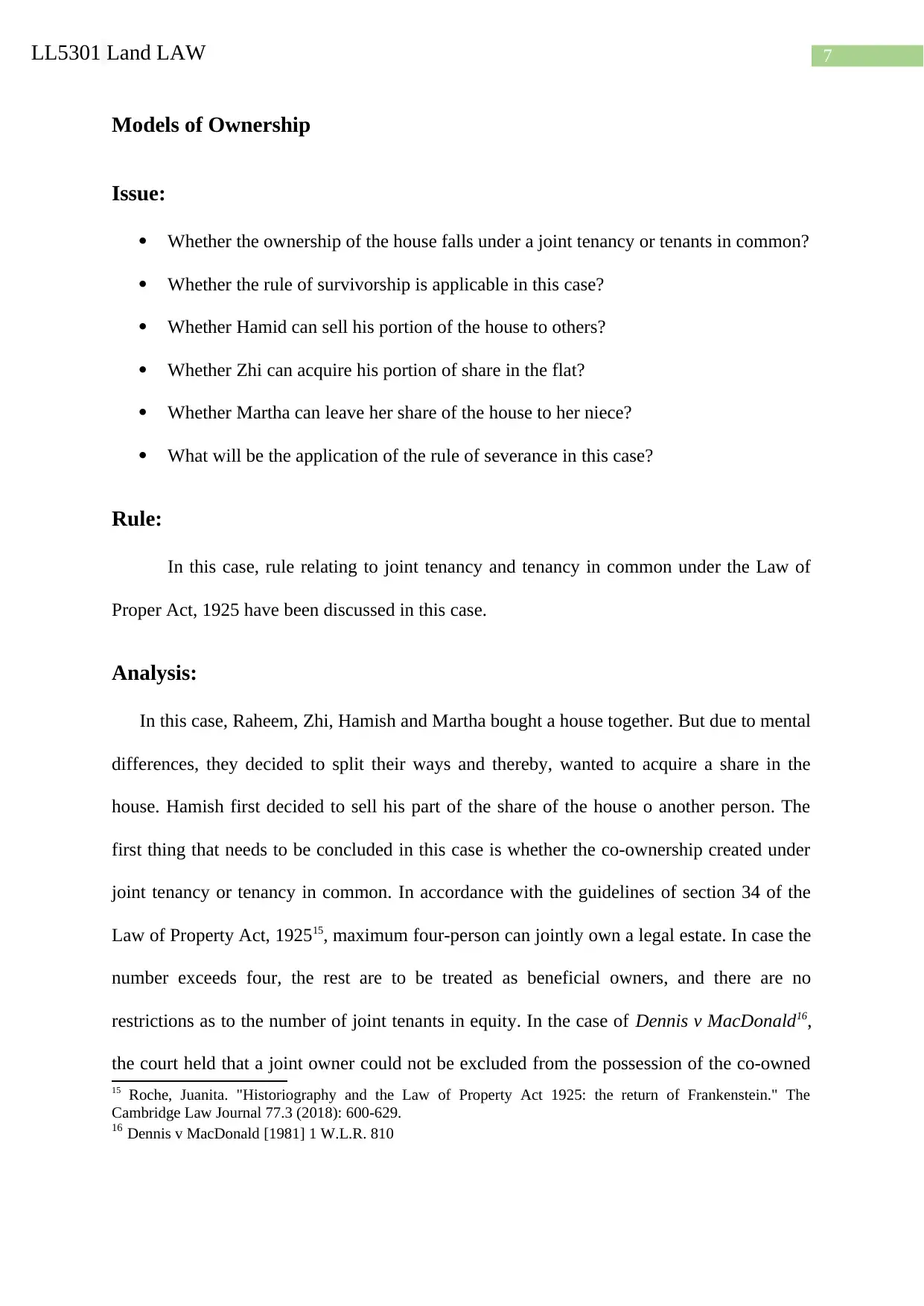
7LL5301 Land LAW
Models of Ownership
Issue:
Whether the ownership of the house falls under a joint tenancy or tenants in common?
Whether the rule of survivorship is applicable in this case?
Whether Hamid can sell his portion of the house to others?
Whether Zhi can acquire his portion of share in the flat?
Whether Martha can leave her share of the house to her niece?
What will be the application of the rule of severance in this case?
Rule:
In this case, rule relating to joint tenancy and tenancy in common under the Law of
Proper Act, 1925 have been discussed in this case.
Analysis:
In this case, Raheem, Zhi, Hamish and Martha bought a house together. But due to mental
differences, they decided to split their ways and thereby, wanted to acquire a share in the
house. Hamish first decided to sell his part of the share of the house o another person. The
first thing that needs to be concluded in this case is whether the co-ownership created under
joint tenancy or tenancy in common. In accordance with the guidelines of section 34 of the
Law of Property Act, 192515, maximum four-person can jointly own a legal estate. In case the
number exceeds four, the rest are to be treated as beneficial owners, and there are no
restrictions as to the number of joint tenants in equity. In the case of Dennis v MacDonald16,
the court held that a joint owner could not be excluded from the possession of the co-owned
15 Roche, Juanita. "Historiography and the Law of Property Act 1925: the return of Frankenstein." The
Cambridge Law Journal 77.3 (2018): 600-629.
16 Dennis v MacDonald [1981] 1 W.L.R. 810
Models of Ownership
Issue:
Whether the ownership of the house falls under a joint tenancy or tenants in common?
Whether the rule of survivorship is applicable in this case?
Whether Hamid can sell his portion of the house to others?
Whether Zhi can acquire his portion of share in the flat?
Whether Martha can leave her share of the house to her niece?
What will be the application of the rule of severance in this case?
Rule:
In this case, rule relating to joint tenancy and tenancy in common under the Law of
Proper Act, 1925 have been discussed in this case.
Analysis:
In this case, Raheem, Zhi, Hamish and Martha bought a house together. But due to mental
differences, they decided to split their ways and thereby, wanted to acquire a share in the
house. Hamish first decided to sell his part of the share of the house o another person. The
first thing that needs to be concluded in this case is whether the co-ownership created under
joint tenancy or tenancy in common. In accordance with the guidelines of section 34 of the
Law of Property Act, 192515, maximum four-person can jointly own a legal estate. In case the
number exceeds four, the rest are to be treated as beneficial owners, and there are no
restrictions as to the number of joint tenants in equity. In the case of Dennis v MacDonald16,
the court held that a joint owner could not be excluded from the possession of the co-owned
15 Roche, Juanita. "Historiography and the Law of Property Act 1925: the return of Frankenstein." The
Cambridge Law Journal 77.3 (2018): 600-629.
16 Dennis v MacDonald [1981] 1 W.L.R. 810
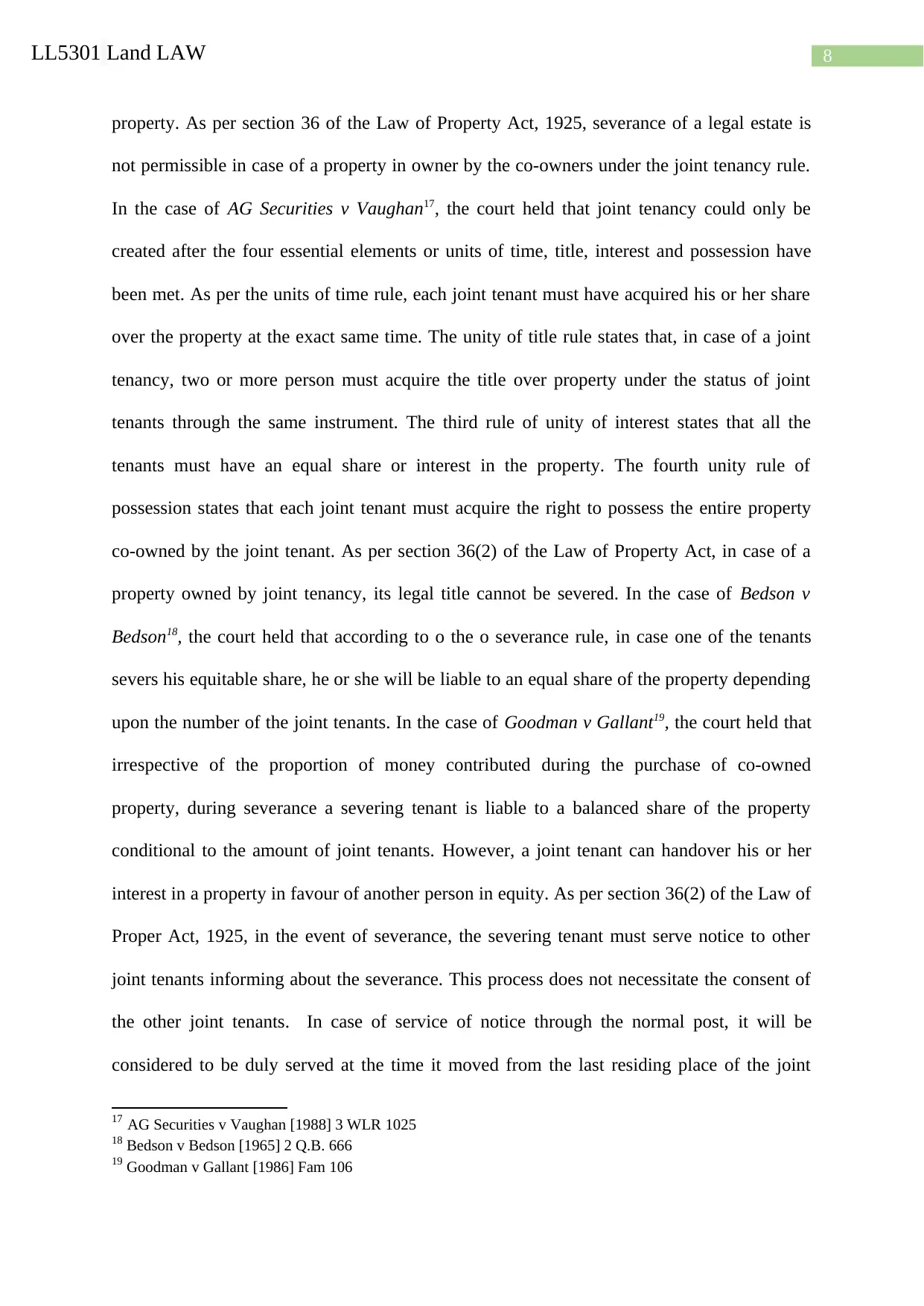
8LL5301 Land LAW
property. As per section 36 of the Law of Property Act, 1925, severance of a legal estate is
not permissible in case of a property in owner by the co-owners under the joint tenancy rule.
In the case of AG Securities v Vaughan17, the court held that joint tenancy could only be
created after the four essential elements or units of time, title, interest and possession have
been met. As per the units of time rule, each joint tenant must have acquired his or her share
over the property at the exact same time. The unity of title rule states that, in case of a joint
tenancy, two or more person must acquire the title over property under the status of joint
tenants through the same instrument. The third rule of unity of interest states that all the
tenants must have an equal share or interest in the property. The fourth unity rule of
possession states that each joint tenant must acquire the right to possess the entire property
co-owned by the joint tenant. As per section 36(2) of the Law of Property Act, in case of a
property owned by joint tenancy, its legal title cannot be severed. In the case of Bedson v
Bedson18, the court held that according to o the o severance rule, in case one of the tenants
severs his equitable share, he or she will be liable to an equal share of the property depending
upon the number of the joint tenants. In the case of Goodman v Gallant19, the court held that
irrespective of the proportion of money contributed during the purchase of co-owned
property, during severance a severing tenant is liable to a balanced share of the property
conditional to the amount of joint tenants. However, a joint tenant can handover his or her
interest in a property in favour of another person in equity. As per section 36(2) of the Law of
Proper Act, 1925, in the event of severance, the severing tenant must serve notice to other
joint tenants informing about the severance. This process does not necessitate the consent of
the other joint tenants. In case of service of notice through the normal post, it will be
considered to be duly served at the time it moved from the last residing place of the joint
17 AG Securities v Vaughan [1988] 3 WLR 1025
18 Bedson v Bedson [1965] 2 Q.B. 666
19 Goodman v Gallant [1986] Fam 106
property. As per section 36 of the Law of Property Act, 1925, severance of a legal estate is
not permissible in case of a property in owner by the co-owners under the joint tenancy rule.
In the case of AG Securities v Vaughan17, the court held that joint tenancy could only be
created after the four essential elements or units of time, title, interest and possession have
been met. As per the units of time rule, each joint tenant must have acquired his or her share
over the property at the exact same time. The unity of title rule states that, in case of a joint
tenancy, two or more person must acquire the title over property under the status of joint
tenants through the same instrument. The third rule of unity of interest states that all the
tenants must have an equal share or interest in the property. The fourth unity rule of
possession states that each joint tenant must acquire the right to possess the entire property
co-owned by the joint tenant. As per section 36(2) of the Law of Property Act, in case of a
property owned by joint tenancy, its legal title cannot be severed. In the case of Bedson v
Bedson18, the court held that according to o the o severance rule, in case one of the tenants
severs his equitable share, he or she will be liable to an equal share of the property depending
upon the number of the joint tenants. In the case of Goodman v Gallant19, the court held that
irrespective of the proportion of money contributed during the purchase of co-owned
property, during severance a severing tenant is liable to a balanced share of the property
conditional to the amount of joint tenants. However, a joint tenant can handover his or her
interest in a property in favour of another person in equity. As per section 36(2) of the Law of
Proper Act, 1925, in the event of severance, the severing tenant must serve notice to other
joint tenants informing about the severance. This process does not necessitate the consent of
the other joint tenants. In case of service of notice through the normal post, it will be
considered to be duly served at the time it moved from the last residing place of the joint
17 AG Securities v Vaughan [1988] 3 WLR 1025
18 Bedson v Bedson [1965] 2 Q.B. 666
19 Goodman v Gallant [1986] Fam 106
⊘ This is a preview!⊘
Do you want full access?
Subscribe today to unlock all pages.

Trusted by 1+ million students worldwide
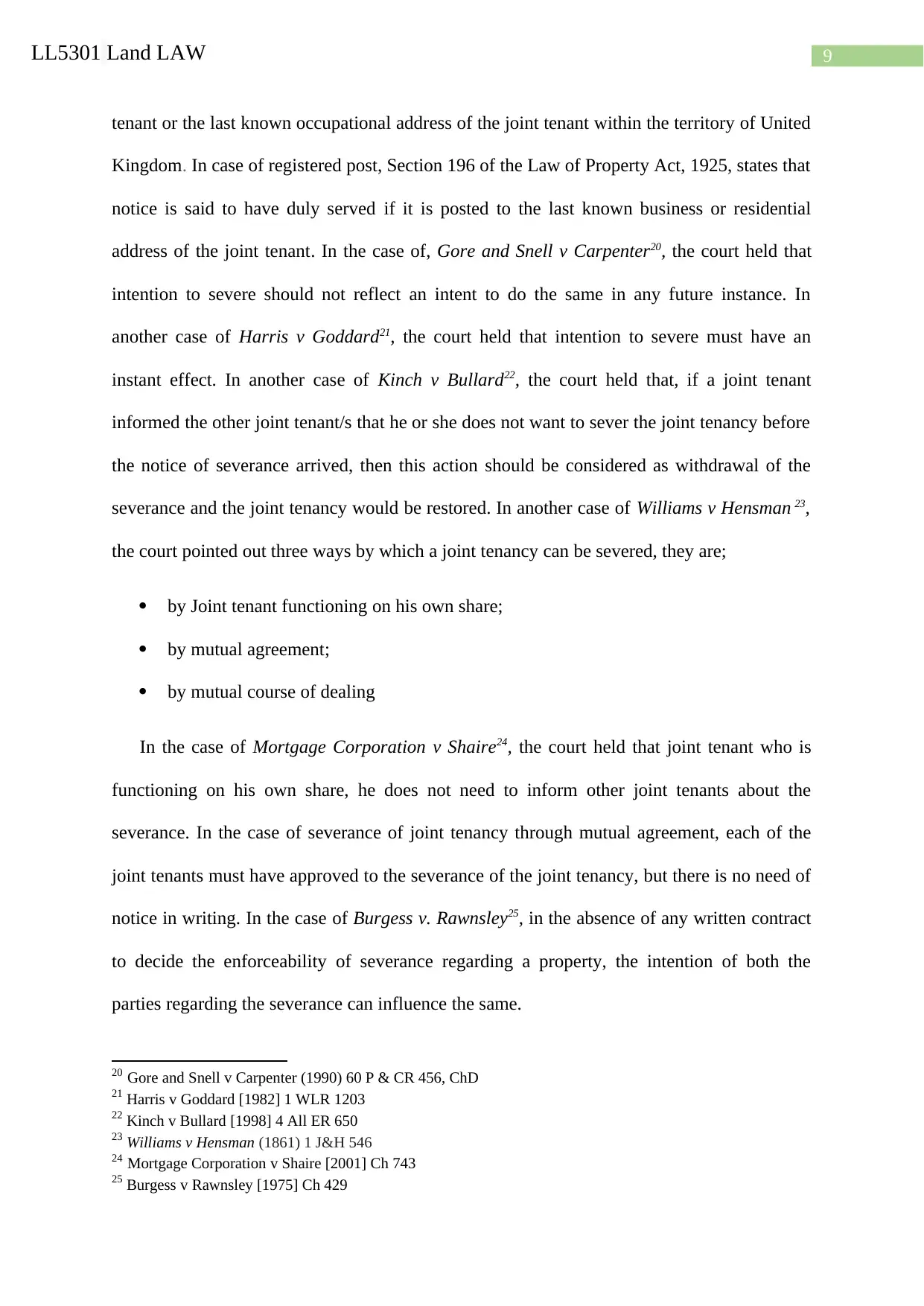
9LL5301 Land LAW
tenant or the last known occupational address of the joint tenant within the territory of United
Kingdom. In case of registered post, Section 196 of the Law of Property Act, 1925, states that
notice is said to have duly served if it is posted to the last known business or residential
address of the joint tenant. In the case of, Gore and Snell v Carpenter20, the court held that
intention to severe should not reflect an intent to do the same in any future instance. In
another case of Harris v Goddard21, the court held that intention to severe must have an
instant effect. In another case of Kinch v Bullard22, the court held that, if a joint tenant
informed the other joint tenant/s that he or she does not want to sever the joint tenancy before
the notice of severance arrived, then this action should be considered as withdrawal of the
severance and the joint tenancy would be restored. In another case of Williams v Hensman 23,
the court pointed out three ways by which a joint tenancy can be severed, they are;
by Joint tenant functioning on his own share;
by mutual agreement;
by mutual course of dealing
In the case of Mortgage Corporation v Shaire24, the court held that joint tenant who is
functioning on his own share, he does not need to inform other joint tenants about the
severance. In the case of severance of joint tenancy through mutual agreement, each of the
joint tenants must have approved to the severance of the joint tenancy, but there is no need of
notice in writing. In the case of Burgess v. Rawnsley25, in the absence of any written contract
to decide the enforceability of severance regarding a property, the intention of both the
parties regarding the severance can influence the same.
20 Gore and Snell v Carpenter (1990) 60 P & CR 456, ChD
21 Harris v Goddard [1982] 1 WLR 1203
22 Kinch v Bullard [1998] 4 All ER 650
23 Williams v Hensman (1861) 1 J&H 546
24 Mortgage Corporation v Shaire [2001] Ch 743
25 Burgess v Rawnsley [1975] Ch 429
tenant or the last known occupational address of the joint tenant within the territory of United
Kingdom. In case of registered post, Section 196 of the Law of Property Act, 1925, states that
notice is said to have duly served if it is posted to the last known business or residential
address of the joint tenant. In the case of, Gore and Snell v Carpenter20, the court held that
intention to severe should not reflect an intent to do the same in any future instance. In
another case of Harris v Goddard21, the court held that intention to severe must have an
instant effect. In another case of Kinch v Bullard22, the court held that, if a joint tenant
informed the other joint tenant/s that he or she does not want to sever the joint tenancy before
the notice of severance arrived, then this action should be considered as withdrawal of the
severance and the joint tenancy would be restored. In another case of Williams v Hensman 23,
the court pointed out three ways by which a joint tenancy can be severed, they are;
by Joint tenant functioning on his own share;
by mutual agreement;
by mutual course of dealing
In the case of Mortgage Corporation v Shaire24, the court held that joint tenant who is
functioning on his own share, he does not need to inform other joint tenants about the
severance. In the case of severance of joint tenancy through mutual agreement, each of the
joint tenants must have approved to the severance of the joint tenancy, but there is no need of
notice in writing. In the case of Burgess v. Rawnsley25, in the absence of any written contract
to decide the enforceability of severance regarding a property, the intention of both the
parties regarding the severance can influence the same.
20 Gore and Snell v Carpenter (1990) 60 P & CR 456, ChD
21 Harris v Goddard [1982] 1 WLR 1203
22 Kinch v Bullard [1998] 4 All ER 650
23 Williams v Hensman (1861) 1 J&H 546
24 Mortgage Corporation v Shaire [2001] Ch 743
25 Burgess v Rawnsley [1975] Ch 429
Paraphrase This Document
Need a fresh take? Get an instant paraphrase of this document with our AI Paraphraser
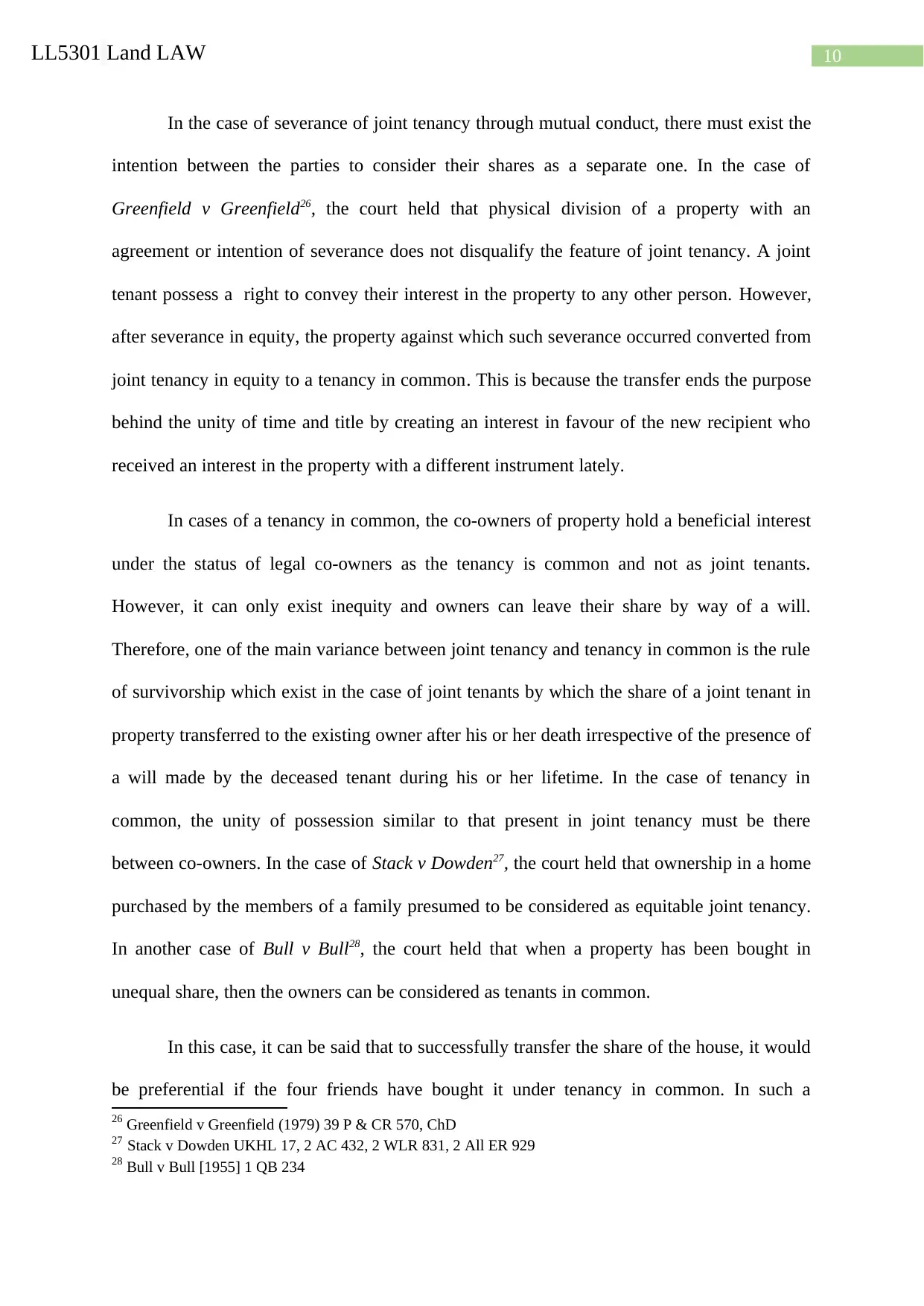
10LL5301 Land LAW
In the case of severance of joint tenancy through mutual conduct, there must exist the
intention between the parties to consider their shares as a separate one. In the case of
Greenfield v Greenfield26, the court held that physical division of a property with an
agreement or intention of severance does not disqualify the feature of joint tenancy. A joint
tenant possess a right to convey their interest in the property to any other person. However,
after severance in equity, the property against which such severance occurred converted from
joint tenancy in equity to a tenancy in common. This is because the transfer ends the purpose
behind the unity of time and title by creating an interest in favour of the new recipient who
received an interest in the property with a different instrument lately.
In cases of a tenancy in common, the co-owners of property hold a beneficial interest
under the status of legal co-owners as the tenancy is common and not as joint tenants.
However, it can only exist inequity and owners can leave their share by way of a will.
Therefore, one of the main variance between joint tenancy and tenancy in common is the rule
of survivorship which exist in the case of joint tenants by which the share of a joint tenant in
property transferred to the existing owner after his or her death irrespective of the presence of
a will made by the deceased tenant during his or her lifetime. In the case of tenancy in
common, the unity of possession similar to that present in joint tenancy must be there
between co-owners. In the case of Stack v Dowden27, the court held that ownership in a home
purchased by the members of a family presumed to be considered as equitable joint tenancy.
In another case of Bull v Bull28, the court held that when a property has been bought in
unequal share, then the owners can be considered as tenants in common.
In this case, it can be said that to successfully transfer the share of the house, it would
be preferential if the four friends have bought it under tenancy in common. In such a
26 Greenfield v Greenfield (1979) 39 P & CR 570, ChD
27 Stack v Dowden UKHL 17, 2 AC 432, 2 WLR 831, 2 All ER 929
28 Bull v Bull [1955] 1 QB 234
In the case of severance of joint tenancy through mutual conduct, there must exist the
intention between the parties to consider their shares as a separate one. In the case of
Greenfield v Greenfield26, the court held that physical division of a property with an
agreement or intention of severance does not disqualify the feature of joint tenancy. A joint
tenant possess a right to convey their interest in the property to any other person. However,
after severance in equity, the property against which such severance occurred converted from
joint tenancy in equity to a tenancy in common. This is because the transfer ends the purpose
behind the unity of time and title by creating an interest in favour of the new recipient who
received an interest in the property with a different instrument lately.
In cases of a tenancy in common, the co-owners of property hold a beneficial interest
under the status of legal co-owners as the tenancy is common and not as joint tenants.
However, it can only exist inequity and owners can leave their share by way of a will.
Therefore, one of the main variance between joint tenancy and tenancy in common is the rule
of survivorship which exist in the case of joint tenants by which the share of a joint tenant in
property transferred to the existing owner after his or her death irrespective of the presence of
a will made by the deceased tenant during his or her lifetime. In the case of tenancy in
common, the unity of possession similar to that present in joint tenancy must be there
between co-owners. In the case of Stack v Dowden27, the court held that ownership in a home
purchased by the members of a family presumed to be considered as equitable joint tenancy.
In another case of Bull v Bull28, the court held that when a property has been bought in
unequal share, then the owners can be considered as tenants in common.
In this case, it can be said that to successfully transfer the share of the house, it would
be preferential if the four friends have bought it under tenancy in common. In such a
26 Greenfield v Greenfield (1979) 39 P & CR 570, ChD
27 Stack v Dowden UKHL 17, 2 AC 432, 2 WLR 831, 2 All ER 929
28 Bull v Bull [1955] 1 QB 234
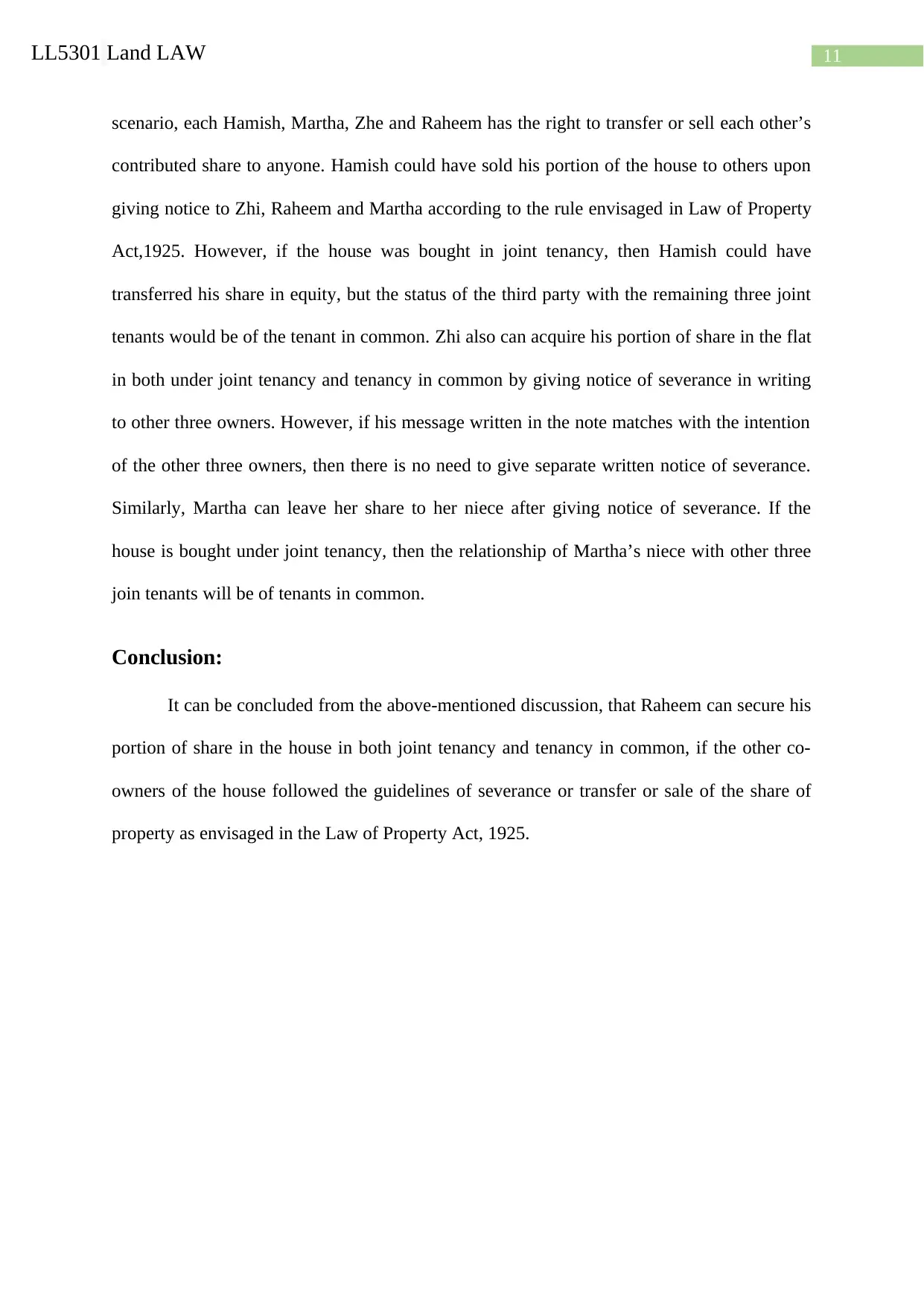
11LL5301 Land LAW
scenario, each Hamish, Martha, Zhe and Raheem has the right to transfer or sell each other’s
contributed share to anyone. Hamish could have sold his portion of the house to others upon
giving notice to Zhi, Raheem and Martha according to the rule envisaged in Law of Property
Act,1925. However, if the house was bought in joint tenancy, then Hamish could have
transferred his share in equity, but the status of the third party with the remaining three joint
tenants would be of the tenant in common. Zhi also can acquire his portion of share in the flat
in both under joint tenancy and tenancy in common by giving notice of severance in writing
to other three owners. However, if his message written in the note matches with the intention
of the other three owners, then there is no need to give separate written notice of severance.
Similarly, Martha can leave her share to her niece after giving notice of severance. If the
house is bought under joint tenancy, then the relationship of Martha’s niece with other three
join tenants will be of tenants in common.
Conclusion:
It can be concluded from the above-mentioned discussion, that Raheem can secure his
portion of share in the house in both joint tenancy and tenancy in common, if the other co-
owners of the house followed the guidelines of severance or transfer or sale of the share of
property as envisaged in the Law of Property Act, 1925.
scenario, each Hamish, Martha, Zhe and Raheem has the right to transfer or sell each other’s
contributed share to anyone. Hamish could have sold his portion of the house to others upon
giving notice to Zhi, Raheem and Martha according to the rule envisaged in Law of Property
Act,1925. However, if the house was bought in joint tenancy, then Hamish could have
transferred his share in equity, but the status of the third party with the remaining three joint
tenants would be of the tenant in common. Zhi also can acquire his portion of share in the flat
in both under joint tenancy and tenancy in common by giving notice of severance in writing
to other three owners. However, if his message written in the note matches with the intention
of the other three owners, then there is no need to give separate written notice of severance.
Similarly, Martha can leave her share to her niece after giving notice of severance. If the
house is bought under joint tenancy, then the relationship of Martha’s niece with other three
join tenants will be of tenants in common.
Conclusion:
It can be concluded from the above-mentioned discussion, that Raheem can secure his
portion of share in the house in both joint tenancy and tenancy in common, if the other co-
owners of the house followed the guidelines of severance or transfer or sale of the share of
property as envisaged in the Law of Property Act, 1925.
⊘ This is a preview!⊘
Do you want full access?
Subscribe today to unlock all pages.

Trusted by 1+ million students worldwide
1 out of 42
Related Documents
Your All-in-One AI-Powered Toolkit for Academic Success.
+13062052269
info@desklib.com
Available 24*7 on WhatsApp / Email
![[object Object]](/_next/static/media/star-bottom.7253800d.svg)
Unlock your academic potential
Copyright © 2020–2025 A2Z Services. All Rights Reserved. Developed and managed by ZUCOL.





